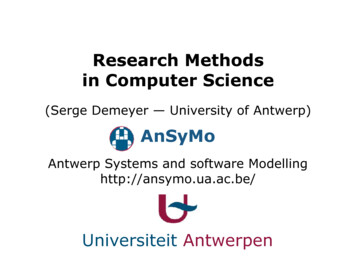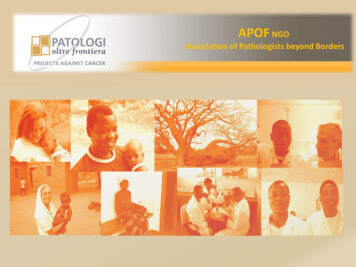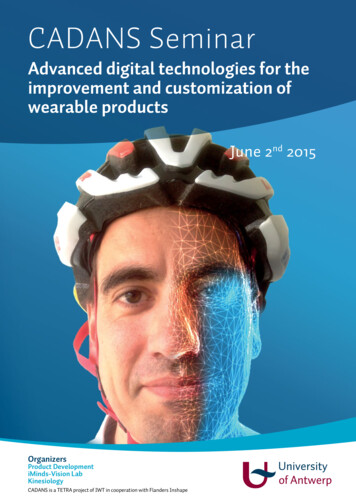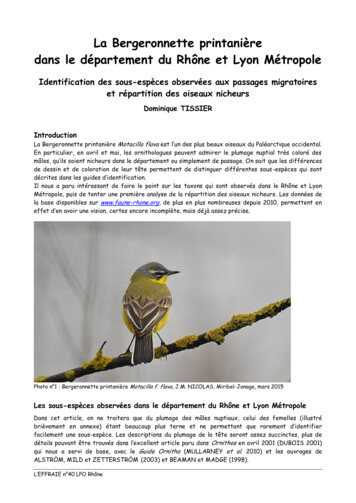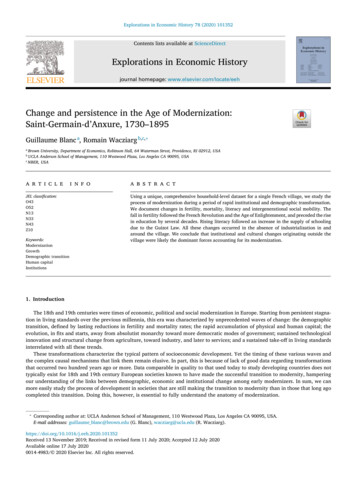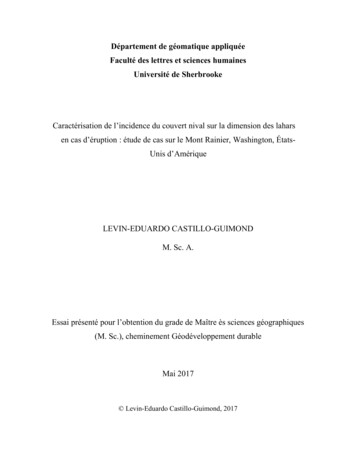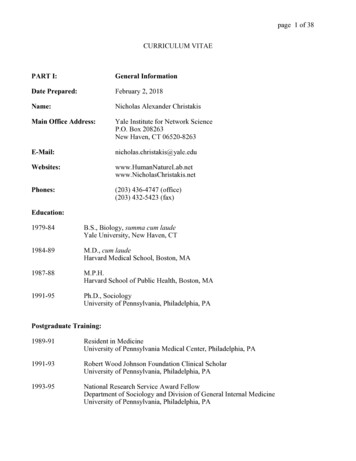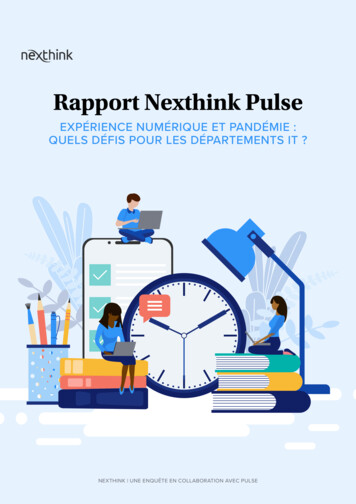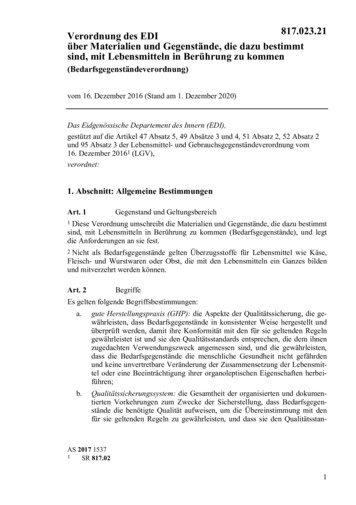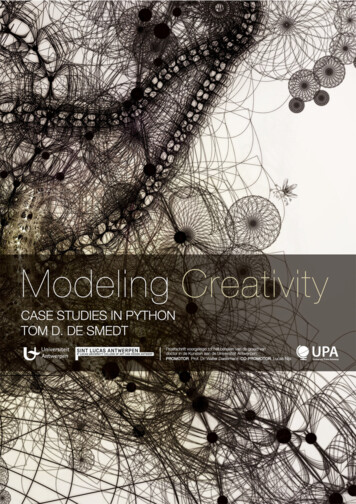
Transcription
TOM DE SMEDT — MODELING CREATIVITYFaculteit Letteren en WijsbegeerteDepartement TaalkundeModeling CreativityCASE STUDIES IN PYTHONComputermodellen van Creativiteit:Gevalstudies in de Python-programmeertaalProefschrift voorgelegd tot het behalen vande graad van doctor in de Kunstenaan de Universiteit Antwerpente verdedigen doorTom De SmedtPROMOTORProf. dr. Walter DaelemansCLiPS Computational Linguistics GroupUniversiteit AntwerpenCO-PROMOTORLucas NijsEMRG Experimental Media Research GroupSt. Lucas University College of Art & Design, AntwerpenAntwerpen, 20131
TOM DE SMEDT — MODELING CREATIVITYCover artwork: SELF-REPLICATION (Tom De Smedt & Ludivine Lechat)The fonts in the book are Computer Modern, Helvetica Neue, Arialand Courier New. The text was written in Google Docs. The layoutwas processed in LibreOffice. The illustrations were done in NodeBox.Computer Modern, LibreOffice and NodeBox are free and open source.Print: Silhouet, Maldegem 2013 Tom De Smedt2013 Uitgeverij UPA University Press AntwerpUPA is an imprint of ASP nv (Academic and Scientific Publishers nv)Ravensteengalerij 28B-1000 BrusselsTel. 32 (0)2 289 26 50Fax 32 (0)2 289 26 59E-mail: info@aspeditions.bewww.upa-editions.beISBN 978 90 5718 260 0NUR 984 / 616 / 656Legal deposit D/2013/11.161/016All rights reserved. No part of this book may be reproduced ortransmitted in any form or by any means, electronic, mechanical,photocopying, recording, or otherwise, without the prior writtenpermission of the author.2
TOM DE SMEDT — MODELING CREATIVITYModeling CreativityCASE STUDIES IN PYTHONTom De Smedt“Enough!” he said, hoarse with indignation. “How dare youwaste a great talent on such drivel? Either give it decent poemsto write or I call the whole thing off!”“What, those aren't decent poems?” protested Klapaucius.“Certainly not! I didn't build a machine to solve ridiculouscrossword puzzles! That's hack work, not Great Art! Just give ita topic, any topic, as difficult as you like . . .”Klapaucius thought, and thought some more. Finally henodded and said:“Very well. Let's have a poem, lyrical, pastoral, and expressedin the language of pure mathematics. Tensor algebra mainly,with a little topology and higher calculus, if need be. But withfeeling, you understand, and in the cybernetic spirit.”“Love and tensor algebra? Have you taken leave of yoursenses?” Trurl began, but stopped, for his electronic bard wasalready declaiming:Come, let us hasten to a higher plane,Where dyads tread the fairy field of Venn,Their indices bedecked from one to n,Commingled in an endless Markov chain!Come, every frustum longs to be a cone,And every vector dreams of matrices.Hark to the gentle gradient of the breeze:It whispers of a more ergodic zone.[.]– Stanislaw Lem, The Cyberiad, Trurl’s Electronic Bard (1974) Barbara and Tomasz Lem. Used with permission.3
TOM DE SMEDT — MODELING CREATIVITY4
TOM DE SMEDT — MODELING CREATIVITYContentsPrefacePART 117NATUREBlind creativity13Evolution by natural selectiongenetic algorithm competitionEvolutionarily stable strategy (ESS) and cooperationComplex systems and emergent behaviorArtificial lifeDiscussion1516192026272Generative art292.12.22.32.42.5Brief historyOverview of software for generative artNodeBoxNodeBox case studiesDiscussion31363941591.11.21.31.41.51.6PART 2EVOLUTION:THE MIND3Brain-computer interfaces633.13.23.3EEG wireless headsetEEG affective visualizationDiscussion6364674Human tionIntuition and insightA concept search spaceImagination and metaphorCreative thinking testDiscussion727477788081835Computational e adjectivesPERCEPTION: semantic network of common senseDiscussion5
TOM DE SMEDT — MODELING CREATIVITYPART 3LANGUAGE6Computational linguistics1016.16.26.36.46.56.6Natural language processingMBSP for PythonMachine learningPattern for PythonA Mad-Tea Party (creative thinking test revisited)Discussion1041051091171281327Sentiment Analysis1337.17.27.3A subjectivity lexicon for Dutch adjectivesSentiment analysis for political 150Bibliography156Index1646
TOM DE SMEDT — MODELING CREATIVITYPrefaceThe topic of this work is to model creativity using computational approaches. Our aim is toconstruct computer models that exhibit creativity in an artistic context, that is, that are capableof generating or evaluating an artwork (visual or linguistic), an interesting new idea, a subjectiveopinion. The research was conducted in 2008–2012 at the Computational Linguistics ResearchGroup (CLiPS, University of Antwerp) under the supervision of Prof. Walter Daelemans. Priorresearch was also conducted at the Experimental Media Research Group (EMRG, St. LucasUniversity College of Art & Design Antwerp) under the supervision of Lucas Nijs. Early researchfocuses on generative art. Related work is discussed in chapters 1, 2 and 3. More recent researchfocuses on computational creativity and computational linguistics. Related work is discussed inchapters 4, 5, 6 and 7.Generative art, computational creativity and computational linguistics have a common ground increativity. Specifically, they relate in some way to the question if and how machines can becreative and intelligent. In chapter 2, we provide a case study of a computer program that is theauthor of its own artworks. It will turn out that this program is not very creative because itsactions are mostly random, whereas artistic creativity is the result of non-random thoughtprocesses and social consensus. After a summary of the theoretical basis of creativity in chapter4, we direct our attention to a case study involving a program that generates creative ideas. Itwill turn out that the results are interesting, but also that it is difficult to evaluate whether ornot they are novel and useful. In chapter 6, we discuss the PATTERN software package developedin the course of our research, which relies on more formal methods. Chapter 7 uses the softwarefrom chapter 6 to evaluate subjective opinion in text.Intuitively, a model for (artistic) artificial creativity appears to involve the steps illustrated infigure 1. A “good idea”, that is, a novel and appropriate solution to a given problem, is selected orcombined from a pool of many possible ideas (chapters 4 and 5). A work (of art) that capturesthis idea is then created (chapters 2 and 3). The work is then evaluated by the author or acommunity of knowledgeable peers (chapters 6 and 7). Following a negative evaluation, the ideais subsequently adapted (chapter 1). We will test this conjecture in a number of case studies andground it in the literature.Figure 1. Illustrative example of a model for artistic creativity.7
TOM DE SMEDT — MODELING CREATIVITYA brief overview of the different chapters:1. Blind creativityIn this chapter we outline the mechanisms of creativity in nature, which is essentially“blind”. We discuss a computer model for evolution by natural selection, and a computermodel for complexity in agent-based systems. We show how creativity does not arise exnihilo, out of nothing, but rather as the result of a multitude of underlying, interactingprocesses. This is a key argument that allows us to further deconstruct the concept ofcreativity in following chapters.2. Generative artIn this chapter we give an overview of the history of generative art, a rule-based form of artinfluenced by complexity and self-organization in nature (chapter 1). We demonstrate ourPython software packages for producing generative art, NODEBOX and NODEBOX FOROPENGL, and provide a commentary on six case studies in NODEBOX. We argue how thiskind of software offers creative leverage, since users are free to combine any kind offunctionality they want in programming code. Finally, we discuss if and how art created bya machine can really be creative. This raises questions that are further addressed in chapter4 and chapter 5.3. Brain-computer interfacesIn this chapter we discuss VALENCE, a generative art installation created with NODEBOXIt responds to brain activity using a wireless EEG headset. The aim of suchdirect brain-computer interfaces (BCI) is to augment the way in which humanscommunicate with machines. In our approach, we focus on alpha waves (relaxation) andthe valence hypothesis (arousal). This kind of dynamic artwork would not be possible torealize using traditional software.FOR OPENGL.4. Human creativityIn this chapter we provide a brief overview of the psychological study of human creativity,from the network of neurons in the brain that generates the conscious mind – and whichproduces the electrical activity recorded by VALENCE – to creative ideas, intuition anddifferent styles of thought. In particular, we discuss a computational approach to creativity:Boden’s concept search space. It is the theoretical foundation of our PERCEPTION casestudy in chapter 5.5. Computational creativityIn this chapter we will discuss PERCEPTION, a model for computational creativity. Insteadof the visual output in chapters 2 and 3, PERCEPTION models creative thought by means ofanalogy. We use our PATTERN software package (chapter 6) to implement a concept searchspace as a semantic network of related concepts, and search heuristics to traverse thenetwork. The chapter concludes with a discussion of the results and a long-lasting debate inthe field of artificial intelligence.8
TOM DE SMEDT — MODELING CREATIVITY6. Computational linguisticsIn this chapter we present MBSP FOR PYTHON, a memory-based shallow parser, andPATTERN, a Python web mining package. We briefly examine the statistical techniques thatunderpin the software, the vector space model. The aim of PATTERN is to provide a widerange of functionality that can be creatively combined to solve tasks in data mining andnatural language processing. We provide short examples to demonstrate how this works,and an extensive case study in chapter 7.7. Sentiment analysisIn this chapter we discuss a sentiment lexicon for Dutch, and a derivate for English, thatcan be used to predict subjective opinion in text. It is built with and part of PATTERN. Weexamine the methods used, the results, and an interesting case study on political discoursein newspapers. We conclude with a discussion of how this approach can be used to evaluateart appreciation.Our work is presented in a popular scientific tone, using a hands-on approach with case studiesand examples in Python programming code. It is intended for an artistic audience, butresearchers in the field of artificial intelligence may benefit as well from the comprehensivesummary of the evolutionary principles in biology, the psychological study of creativity, and thestatistical principles in natural language processing and machine learning. We hope that our workoffers an engaging discourse on computational creativity.AcknowledgementsThe research was funded by the Industrial Research Fund (IOF) of the University of Antwerp.Artwork for CITY IN A BOTTLE was funded by the Flemish Audiovisual Fund (VAF). Artwork forNANOPHYSICAL and VALENCE was funded by Imec (Interuniversity Microelectronics Centre).Many thanks and honors go to my advisors: Prof. dr. Walter Daelemans at the ComputationalLinguistics Research Group (CLiPS) and Lucas Nijs at the Experimental Media Research Group(EMRG), without whose insight, patience and impatience this work would not exist. Manythanks go to my colleagues at CLiPS and EMRG for assistance and feedback. Many thanks tothe members of the review committee: Prof. dr. Steven Gillis, dr. Tony Veale, dr. JonMcCormack and dr. Guy De Pauw. Many thanks also to Imke Debecker and Jo De Wachter atImec. A special thanks goes to my family for support; to Tom Van Iersel, Ludivine Lechat,Giorgio Olivero and dr. Thomas Crombez for support, feedback and collaboration; and worldwideto the NodeBox, GitHub and MLOSS open source communities.The subjectivity lexicon in chapter 7 was annotated by Nic De Houwer, Lore Douws, AariciaSobrino Fernández, Kimberly Ivens (Computational Models of Language Understanding masterclass), Tim De Cort (postgraduate student at St. Lucas University College of Art & Design),Tom De Smedt and Walter Daelemans.9
TOM DE SMEDT — MODELING CREATIVITY10
TOM DE SMEDT — MODELING CREATIVITYPart INATURE The necessary nasty screeching offlirtatious fitnessquarrelsome andcontentious.An entity exposition,Restlessness–FLOWEREWOLF, Nature (edited)11
TOM DE SMEDT — MODELING CREATIVITY12
TOM DE SMEDT — MODELING CREATIVITY1Blind creativityOne of the most compelling examples of creativity is no doubt life itself. These days, it is harderto spot nature and its diversity at work. Humans have been prolific in urbanizing the planet. Butmany of us will have pleasant childhood memories of going out to explore, to observe a bustlingant colony, to inspect the shapes and colors of flower petals, to wonder at the intricacy of a spiderweb. How can such purposeful intricacy exist, when nature is inherently without purpose?Spider websWebs are what make spiders spiders. But the spider's ancestors didn't venture onto land to beginmaking webs there and then, 400 million years ago. The skill was refined bit by bit. The oldestknown proto-spider (Attercopus fimbriunguis) probably lined its burrow with silk to keep waterout, not to catch prey. There were no flying insects around to catch in any case. Later, single silkthreads would be used around the shelter, as trip-lines for a passerby snack. Gradually, over thecourse of 200 million years, traps became more elaborate, from small ground webs and bush websto the orbicular webs we know today (Craig, 1997 and Vollrath & Selden, 2007).Building a web is an efficient hunting strategy. Instead of rummaging about (which is hard work)the spider can wait for prey to wander in. The spider releases a sticky thread and waits for thewind to blow it away, hook it onto something. It cautiously traverses the thread and reinforces itwith a second line. Then it extends the line with a downward Y-shape, forming the first threeradials of the web (cf. wheel spokes). It constructs an encompassing frame to attach more radialsto. Then, the spider will add a spiraling line from the inside out, using its own body to measurespacing between the lines. Most spiders have three types of spinnerets to produce silk. The firstspiral is constructed with non-sticky silk. It allows the spider to easily move about duringconstruction. It will progressively replace the non-sticky parts with smaller, sticky spirals, fromthe outside in. Building the web requires energy of course. After an unproductive day, the spidermay eat part of its web to recycle the proteins it needs to make silk, and start over (Craig, 1987).Flower petalsFlowers primarily use pollination1 to reproduce. They depend on other organisms (pollinators) totransport pollen grains from the flower stamens to receptive flower carpels, where fertile seeds areproduced. As such, the flower’s colorful petals and fragrance are not intended to gratify humans.They serve as cues to attract pollinators. Insects such as honeybees and butterflies are lured inwith the promise of reward (nectar!) and in turn spread the pollen that stick to their legs whenthey move on to other flowers. Wind-pollinated plants on the other hand have scentless,inconspicuous flowers in shades of brown and green.1Over 80% of crops cultivated for human consumption in Europe (35% worldwide) depend on insect pollinators, beesespecially. Recent studies show a decline in pollinators, for example wild bee communities jeopardized byagricultural intensification (Klein et al., 2007, Gallai, Salles, Settele & Vaissière, 2009).13
TOM DE SMEDT — MODELING CREATIVITYOnce pollinated, some flowers change color, urging visitors to more rewarding neighbors. This“trick” benefits the flower. Fewer pollinator visits are wasted on siblings that can no longer receiveor donate pollen (Delph & Lively, 1989). Some flowers will also wither their petals to decreaseattraction once pollinated, since the pollinators will prefer flowers with more petals (van Doorn,1997). But changing color is the more efficient strategy. This way, visitors can still recognize theplant from a distance and make their choice at closer range (Weiss, 1995). This scenario is notunlike checking the expiry dates in the supermarket.Ant coloniesObserving ants at work is fun. Leave a sugar cube in the vicinity of the nest and before longthere will be a chain of worker ants going back and forth, hauling bits of sugar to the nest. Antsare social insects. They rely on pheromone scent for communication. When food is located, anant will mark the trail with secreted pheromones as it heads back to the colony. Other ants canuse their antennae to assess the direction and intensity of the scent. They will go over to the foodsource, grab a morsel, and reinforce the trail with more pheromones on the way back. Shorterpaths will be traversed faster, reinforced more often, and hence attract even more ants until anoptimal route is established. Once the food source is exhausted, no new scent markers are left, sothe depleted path dissipates. The ants will abandon the path and begin to look for other nearbyfood sources.Social behavior is key to the ant’s success. The survival of the colony does not rely on a singleindividual, but on many ants cooperating. A single worker ant can specialize in the task at hand,for example moving stuff. As long as there are plenty of other workers in the chain, the ant doesnot need to know about the next step. It can simply go on moving stuff. Other ants in the chainwill take care of the next step. If necessary, individual worker ants can switch to group behavior(e.g., a food object or an intruder is too big to handle) by means of recruitment and alarm scentsignals (Hölldobler & Wilson, 1990).SUPERORGANISMHölldobler & Wilson (2009) view the ant colony as a superorganism – an organism consisting ofmany organisms. Individual ants in the colony can be thought of as cells in an organism. Groupsof ants represent different functions of the organism. For example, the worker ant caste resemblesa circulatory system of food distribution (trophallaxis), the soldier ant caste parallels the immunesystem. Hofstadter (1979) uses a similar analogy: Aunt Hillary, a conscious ant hill, whereindividual ants are relatively simple (“as dumb as can be”) but function like neurons in the brainby means of signal propagation. For example, a worker ant confronted with an intruder willrelease alarm signals (pheromones). These are picked up and propagated by more and more ants,until the signals either dissipate by removal of the threat or effectively put the entirecolony/brain in PANIC mode.14
TOM DE SMEDT — MODELING CREATIVITY1.1Evolution by natural selectionSpider webs, flower petals and ant trails are just a few of the creative strategies found throughoutnature. There are many more examples. How can such creative strategies exist, and why? Howdid spiders invent the orbicular web? Why do ants cooperate? This is explained by Darwin’stheory of evolution (1859). A scientific theory is a well-researched framework of corroboratingevidence grounded in empirical phenomena, by means of observation. This differs from thepopular sense of the word “theory”. The theory of evolution is a solid framework that explainshow all life evolved from a universal common ancestor nearly four billion years ago. We provide abrief overview of the mechanisms, relevant to the topic of creativity. For more information, werecommend The Selfish Gene (Dawkins, 1976).COMPETITIONThe driving force behind evolution is competition: competition among plants for nutrients andlight, among spiders that catch bees and bees that prefer not to be caught, among ant coloniesoccupying the same territory, among humans for mates and social status.VARIATION SELECTIONEvolution itself is the process by which organisms develop and diversify across successivegenerations. This happens by means of heredity. Traits are passed on from ancestors to theiroffspring (Fisher, 1930). Today, we know that such traits (e.g., ant foraging behavior) arecontrolled by genes, sequences of DNA. When two organisms of a species reproduce, each parentcontributes half of the offspring’s gene pool. Mutation, errors that occur during DNA replication,may cause changes in an individual’s gene pool. Genetic recombination and mutation producesvariation in the population; new, slightly different traits. Some traits will be beneficial to theorganism’s survival given its surrounding environment. The fittest individuals with the best traitscan reproduce more rapidly, or simply live long enough to reproduce. Gradually, favorable traitswill spread throughout the population. This is called natural selection. As such, evolution is ablind process: it is a complex, non-random process, but it has no predefined goal or design.Spiders that build better webs have more food to eat. They will be fitter and survive longer.They will have more opportunities to reproduce (natural selection). When their genes are passedon, the offspring inherits the web-building traits of its predecessors (evolution). Due to geneticrecombination and mutation, some of the offspring will mess up their webs. But others will refinethe technique further (variation). When insects diversified 200 million years ago, spiders thattook advantage of this new food source by building orb webs prospered. The spider did not“want” or “plan” to build a better web. Those that did simply did better. Likewise, floral colorchange or petal withering allows flowers to be pollinated faster. Consequently, such propertiespropagate. Ants cooperate because the behavior is mutually beneficial (Jackson & Ratnieks,2007). Suppose one worker ant passes its chunk of sugar to another worker ant, which then takesoff to keep the food for itself. The deceptive ant would thrive and the cooperative ant wouldstarve. Natural selection will favor cooperation. All chunks of sugar eventually end up at the nestfor all to enjoy, so there is no harm in cooperating. On the contrary, it enables the ants to processfood sources that would otherwise be too large to handle individually.15
TOM DE SMEDT — MODELING CREATIVITY1.2EVOLUTION: genetic algorithm competitionEVOLUTION (see also De Smedt, Lechat & Daelemans, 2011) is a computer model for evolution bynatural selection. The project is an extension of Ludivine Lechat’s thesis project GRAPHIC2CELLULAR DOMESTICATION (GCD). Like many of Lechat’s artworks , GCD consists of visualelements that can be combined into different shapes (typically lifeforms) using a set of rules. Thiskind of rule-based art is also called generative art, discussed in chapter 2. Lechat’s work was doneby hand. In EVOLUTION we expound on this by using an automated, computational approach.The game starts out with a set of insect creatures randomly designed from a pool of components:heads, legs, wings, tails, and so on. Different components have a behavioral impact. For example,bigger eyes and antennae allow a creature to employ better hunting strategies (ambush,intercept). Larger wings allow a creature to fly faster. A longer tail allows more efficient steering.Figure 2. EVOLUTION. Three evolved creatures and an ongoing fight between two species.2http://www.ludivinelechat.be/16
TOM DE SMEDT — MODELING CREATIVITYFITNESS ! CONVERGENCEWe then used a genetic algorithm to evolve better creatures. A genetic algorithm (Holland, 1992)is a search technique used in artificial intelligence (AI) computer programs, based on naturalselection. A straightforward Python implementation is included in the appendix. Central to thetechnique is the fitness function. The fitness function calculates a score (e.g., 0.0–1.0) for eachcandidate in a population. Given a population of candidates, the algorithm will then select, pairand recombine the fittest candidates to create a new population. With each consecutivegeneration the population’s average fitness increases, slowly converging to an optimal solution. Aknown weakness of the technique is that the optimal solution can be either global or local. Localoptima occur when the algorithm converges too fast. This happens when weaker candidates arediscarded too early, since they can introduce useful variation if retained and combined with fittercandidates. A well-known solution is to use an amount of random mutation to maintain diversityand avoid local optima.The GA’s fitness function in EVOLUTION is the game itself: an interactive hunting ground wherecreatures are pitted against each other. Creatures that survive the competition are allowed toreproduce. Two creatures from the pool of survivors are randomly recombined into a newcreature. For example, the “Rurat” and “Qaqaf” creatures shown in figure 2 might produce anoffspring called “Quraf”, that sports the large flippers of the first parent and the elegant tentaclesof the second parent.In our setup we used hierarchical fair competition (Hu & Goodman, 2002) instead of mutation toavoid local optima. This means that the game is hierarchically fair in the sense that even highlyevolved creatures still face a steady supply of new genetic material (new random creatures tofight). Interestingly, the setup often produces an endless crash-and-bloom cycle of 1) creaturesthat are exceptional but flawed and 2) mediocre all-rounders. Random newcomers will eventuallybeat the current (mediocre) winner with an “exceptional trick” (e.g., very aggressive very fast),but are in turn too unstable to survive over a longer period (e.g., unable to cope withcooperating adversaries). Their trick enters the gene pool but is dominated by generations ofolder DNA, leading to a slow overall evolution. Figure 2 shows three evolved creatures and a fightbetween two species.17
TOM DE SMEDT — MODELING CREATIVITYIn 2009, we expanded EVOLUTION into a procedural computer game called CITY IN A BOTTLE(Marinus, Lechat, Vets, De Bleser & De Smedt, 2009) that features more complex scenarios, suchas interaction between plants and insects. Figures 3.1 and 3.2 show development screenshots.Computer models that evolve virtual creatures are part of a field called artificial life. Otherexamples include Dawkins’ BIOMORPH and Sims’ EVOLVED VIRTUAL CREATURES. These focus ongenerating fitter creatures as a task in itself, whereas EVOLUTION focuses on competition betweencreatures. We will discuss artificial life in more detail shortly. First, we will look at evolutionarystrategies such as competition and cooperation, and how a multitude of such strategies can giverise to complex systems in which creative behavior seemingly arises ex nihilo, out of nothing.Figure 3.1. Screenshot of the procedural game world in CITY IN A BOTTLE.Figure 3.2. Screenshot of procedural creatures in CITY IN A BOTTLE.18
TOM DE SMEDT — MODELING CREATIVITY1.3Evolutionarily stable strategy (ESS) and cooperationEvolution by natural selection is often understood as “the survival of the fittest”. In this sense itseems to imply that only strong, selfish organisms survive. The idea that selfish behavior is thenatural state is a deceptive simplification that can be exploited to promote for example greed andethnic violence (Marsella, 2005). On the contrary, it is often rewarding to play a cooperativeevolutionary strategy. Each strategy has its own costs and benefits. This concept was firstformalized by Maynard Smith & Price (1973) using a branch of mathematics called game theory.A strategy is a pre-programmed (genetic) behavioral policy. For example, “attack opponent” or“attack opponent if provoked”. An evolutionarily stable strategy (ESS) is a strategy adopted bymost members of the population. Once an ESS is established it is very hard to replace it withanother strategy. In other words, the best strategy for an individual depends on what themajority of the population is doing (Dawkins, 1976), as illustrated by the following example:NICE ! NASTYImagine a population of ants where all ants are fighting each other. There is no benefit in sharingfood, since none of the other ants will share. This kind of reciprocal “nasty” strategy is costly.Whenever an ant is hungry it may end up in a vicious fight over a food source. In fact, it is theworst possible strategy, since no party will yield; all ants need to eat. To clarify this we canconstruct a payoff matrix (table 1). Say that if an ant wins a conflict, it eats the food and scores 10. If it loses it dies and scores -100. All ants are equally nasty, so we can expect each ant towin half of the conflicts and lose half. On average, each ant scores -45. Now, suppose there is agoofy ant that doesn’t fight, but instead attempts to share. If it doesn’t work out it runs away. Ifit can share, it eats half of the food and scores 5. It it runs away, it gets 0 for wasting time. Onaverage it scores 2.5, which is better than -45. Opportunity arises for ants that cooperate orflee instead of starting a fight. As more of them appear in the population their individual scoreswill rise to 5. Both NICE and NASTY strategies can be evolutionarily stable. In a populationwhere all ants are cooperating, a single NASTY always gets the food (since all others run away).Its individual score is 10, so it prospers. In the end there will be a stable ratio between a part ofthe population with a NICE ESS and a part with a NASTY ESS.PAYOFF MATRIXNASTYNICENASTY(V-C)/2, (V-C)/2V, 0NICE0, VV/2, V/2Table 1. Payoff matrix for NASTY and NICE strategies, also known as Hawk-Dove.Let the value of a food resource V 10 and the cost of an escalated fight C -100.Once an ESS is established, things calm down. This ties in with the proposition that evolutionarychanges occur relatively fast, alternated with longer periods of relative evolutionary stability(Gould, 1972).19
TOM DE SMEDT
6.2 MBSP for Python 105 6.3 Machine learning 109 6.4 Pattern for Python 117 6.5 A Mad-Tea Party (creative thinking test revisited) 128 6.6 Discussion 132 7 Sentiment Analysis 133 7.1 A subjectivity lexicon for Dutch adjectives 133 7.2 Sentiment analysis for political discourse 138 7.3 Discussion 145 Conclusions 146 Appendix 150
